For podiatrists, a well-designed website is not just a digital brochure. It is a powerful tool for attracting new patients, building trust, and streamlining operations. The best podiatrist websites go beyond looks by combining functionality, accessibility, and patient-focused features.
A great podiatry website design can set you apart from the competition by providing a seamless, user-friendly experience that encourages visitors to book an appointment.
This guide explores what makes the best podiatrist websites so effective. We will look at key design principles, inspiring examples, and actionable ideas you can apply to your site.
You’ll learn how to create a website that looks professional and works for your business.
Why Podiatrist Websites Need Strong Design to Attract and Retain Patients?
Your website is often the first interaction a potential patient has with your practice. It must convey professionalism, expertise, and a welcoming atmosphere.
The design of your site plays a critical role in shaping this perception. A strong podiatry website design can directly influence a patient’s decision to choose your practice.

The Role of First Impressions in Patient Decision Making
When a user lands on your website, they make a snap judgment about your practice. A professional, clean, and modern design immediately builds credibility. It signals that you are a reliable, up-to-date healthcare provider.
Conversely, an outdated or cluttered site can create doubt. It might suggest that your practice is not keeping up with modern standards.
A patient-focused website design makes the user feel understood and cared for. High-quality images of your office and staff can create a personal connection.
A clear and inviting layout reduces anxiety. This positive initial impression makes visitors more likely to explore your services and eventually become patients.
How User-Friendly Navigation Improves Patient Engagement?
Patients searching for a podiatrist are often in pain or have a specific problem to solve. They need to find information quickly and easily. User-friendly navigation is key to a successful website. This means having a clear menu structure, intuitive links, and a simple sitemap.
A well-organized site allows patients to find their needs in just a few clicks. This might include information on common conditions like bunions or plantar fasciitis, a list of services, or patient forms.
When the website is easy to use, it improves patient engagement and reduces frustration. This positive experience reflects well on your practice and makes patients more likely to schedule an appointment.
The Impact of Mobile-Responsive Podiatrist Websites
More people than ever are using their smartphones to search for local businesses, including doctors. A mobile-responsive medical website design is no longer optional. It’s a necessity.
A mobile-friendly site automatically adjusts its layout and content to fit any screen size. This ensures a consistent and positive user experience, whether a patient is on a desktop, tablet, or phone.
Google also prioritizes mobile-friendly websites in its search rankings. If your site isn’t mobile-responsive, you could lose potential patients to competitors.
A mobile-optimized sit e helps improve your SEO for podiatrist websites and makes it easier for patients to contact you on the go with features like click-to-call buttons. This is a crucial element of any modern podiatry web design.
Build a High-Performing WordPress Website
Partner with Seahawk’s expert developers to create a custom, SEO-friendly podiatry WordPress site that scales with your business and drives conversions.
Key Elements Every Podiatrist’s Website Should Include
Your website needs to be more than just visually appealing to be effective. It must also be functional and informative. Here are the essential components for a high-performing podiatry website.
- Services Page: A detailed list of all the treatments and conditions you specialize in. This helps patients understand your expertise. Use clear headings and descriptions.
- About Us Page: Introduce your podiatrists and staff. This builds trust and personal connection. Include professional photos and short bios.
- Patient Resources: A dedicated section for patient forms, insurance information, and post-treatment care instructions. This streamlines the patient onboarding process.
- Online Scheduling System: Doctors must have an easy-to-use appointment booking system. This allows patients to book 24/7, reducing phone calls and administrative work.
- Blog/Resource Library: Educational content establishes your authority. A blog with articles about foot health and common issues shows you are a thought leader.
- Testimonials and Reviews: Showcase positive feedback from current and past patients. This provides social proof and builds confidence in your services.
- Contact Information: Your phone number, address, and map should be clearly and prominently displayed. An online contact form is also essential.
Best Podiatrist Websites with Inspiring Design Examples
Looking for podiatry web design inspiration? Some of the best podiatrist websites combine strong design with excellent functionality. These podiatry website examples offer great ideas you can adapt for your own custom podiatry websites.
Hadfield Foot and Ankle
Hadfield Foot and Ankle has a clean, professional design emphasizing high-quality visuals. Clear headings and a simple color scheme make it easy to read. Key features like “Request an Appointment” are prominently displayed.

The site balances a professional look with a patient-friendly feel, making it one of the best podiatry website design examples.
Santa Clara Foot Care Center
Santa Clara‘s website uses a modern, uncluttered layout. It immediately provides key information and services on the homepage.
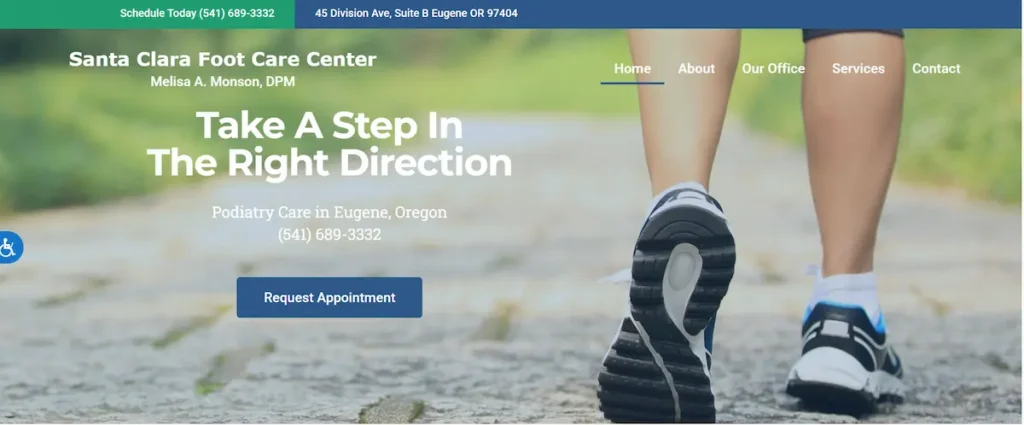
The site is an excellent example of a patient-focused website design, with clear calls-to-action for new patients. It’s easy to navigate, with dedicated pages for conditions and treatments.
Anderson Podiatry Center
Anderson Podiatry Center‘s website is a masterclass in user experience. It features a live chat function for instant patient communication.
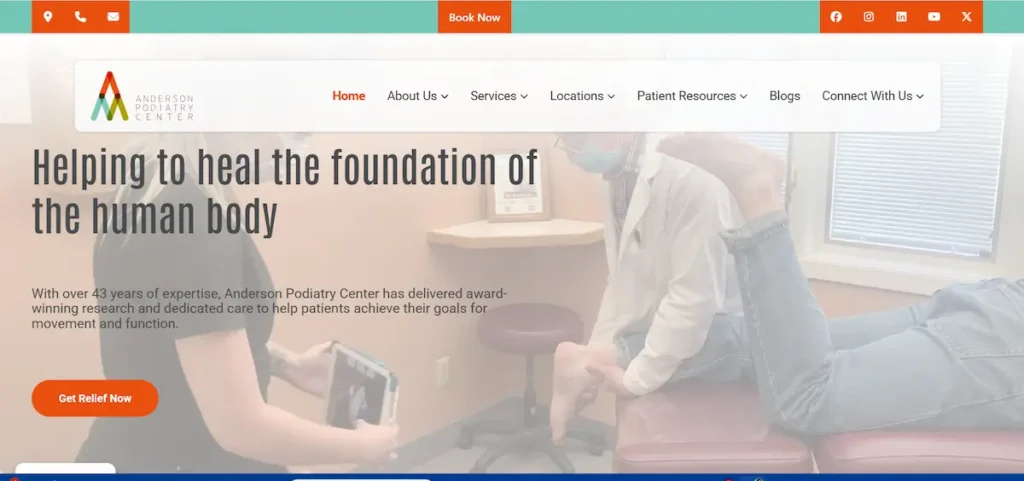
A background video on the homepage provides a dynamic, engaging feel. The straightforward menu and large buttons make it simple to find information, demonstrating what makes a good podiatrist website.
Oklahoma Foot and Ankle Treatment Center
Oklahoma Foot and Ankle Treatment Center uses a warm color palette and inviting imagery. It feels personal and welcoming. The design highlights patient education with a blog section and a list of common conditions.
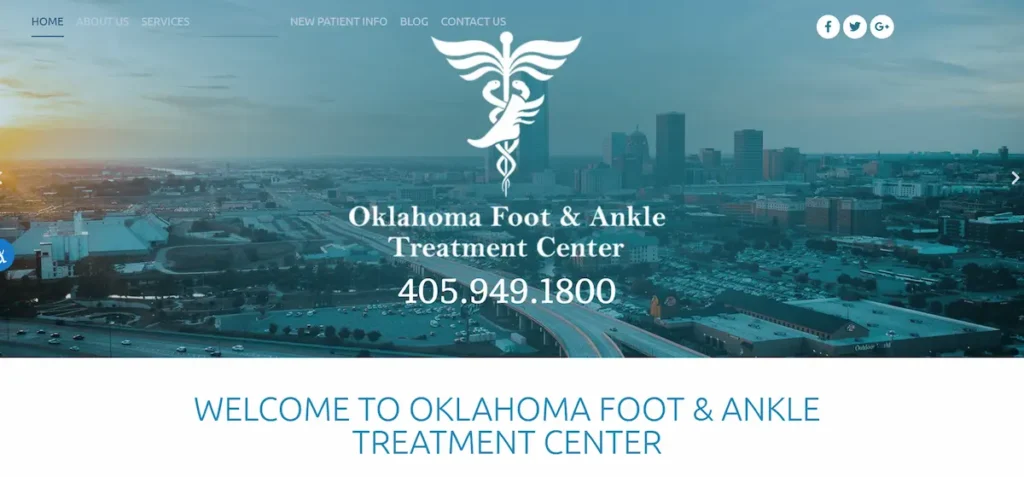
The straightforward navigation ensures a smooth journey for visitors.
Carolina Foot & Ankle Associates
The website for Carolina Foot & Ankle Associates is an excellent example of a professional healthcare website design. It uses a clean and simple design, strongly emphasizing branding.
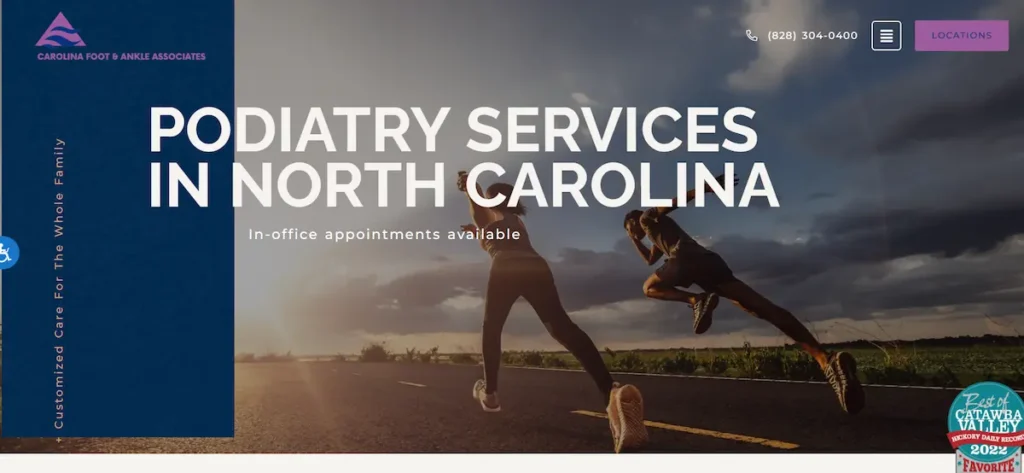
The site makes it easy for patients to find a location and book an appointment, showcasing efficient podiatry practice websites.
Appalachian Foot & Ankle Associates
The site for Appalachian Foot & Ankle Associates is simple yet effective. Its minimalist design focuses on the most critical information.
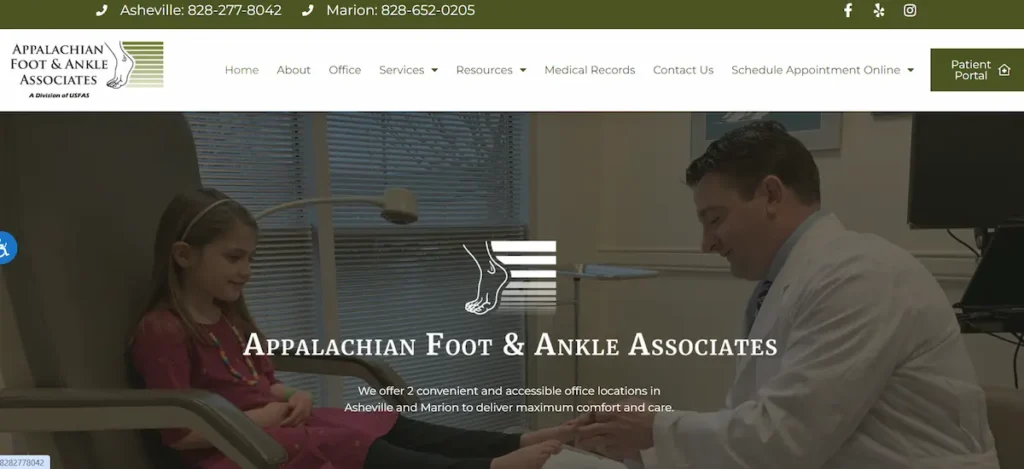
The easy-to-read font and clear calls to action guide the user effortlessly. It proves that a great podiatry website doesn’t need to be complex.
Bespoke Podiatry
Bespoke Podiatry’s website is a high-end example of professional branding for doctors. It uses a sleek, sophisticated design that conveys a sense of quality and modernity.

The site is visually striking and focuses on a luxury patient experience, offering a unique take on podiatry web design.
Design Ideas You Can Apply to Your Own Podiatrist Website
You don’t need to be a design expert to create a great website. You can use these podiatry website design ideas to improve your own site’s look and feel.
- Choose a Clean, Professional Color Scheme: Use a limited palette of 2-3 colors. Blues and greens often evoke a sense of calm and trust in healthcare website design.
- Use High-Quality Imagery: Replace stock photos with professional images of your practice, staff, and happy patients (with their consent, of course).
- Simplify Navigation: A menu with no more than 5-7 main items is ideal. Use clear labels like “Services,” “About Us,” and “Contact.”
- Incorporate Video: A short, professional video on your homepage can introduce your practice and build rapport with visitors.
- Make Your Contact Information Prominent: Put your phone number and “Request an Appointment” button in the header of every page.
- Add Testimonials and Patient Reviews: A rotating carousel or a dedicated page for testimonials adds instant credibility. This is a key part of building trust with new patients.
How to Choose the Right Web Designer for Your Podiatry Practice?
Finding the right partner to create your website is crucial. A great design can fail if the technical foundation is weak. Here’s what to look for when choosing a web designer for podiatry practice.
- Healthcare Experience: Look for a designer or agency with a portfolio of medical practice website design. They understand the unique needs and regulations, such as HIPAA-compliant podiatrist websites.
- HIPAA and ADA Compliance: Your website must be secure and accessible to all users. The designer must follow both HIPAA and ADA compliance guidelines. ADA-compliant podiatry websites are crucial for providing equal access to information for people with disabilities.
- Portfolio and Testimonials: Review their past work and read what other clients have to say. This gives you insight into their quality and professionalism.
- Ongoing Support: Web maintenance and updates are essential. Choose a designer who offers continued support and security services.
Why Seahawk Media is a Great Choice for Podiatry Websites?
Seahawk Media creates high-performing medical and podiatry websites that combine professional design, patient-friendly features, and powerful SEO.
With expertise in WordPress development, HIPAA compliance, and ADA accessibility, Seahawk ensures your website is both secure and optimized for growth.
Their team provides end-to-end services, from branding and design to local SEO and ongoing support, making them the perfect partner for podiatrists who want a website that attracts new patients and strengthens their practice online.
Technical and SEO Optimizations for WordPress Podiatry Sites
WordPress is a popular choice for medical websites due to its flexibility. You must implement specific technical and SEO optimizations to ensure your WordPress site performs well and ranks high on Google. This is where SEO for podiatrist websites comes into play.
- Keyword Research: Identify the terms your patients are using to find you. Focus on local keywords like “podiatrist near me” or “foot doctor [your city]”.
- On-Page SEO: Optimize your H1, H2, and H3 headings. Use your primary and secondary keywords naturally throughout your content. Create a dedicated page for each service you offer.
- Local SEO: Claim and optimize your Google Business Profile. Ensure your Name, Address, and Phone Number (NAP) are consistent across all online directories.
- Mobile Optimization: Use a responsive WordPress theme. Test your site’s mobile performance with Google’s Mobile-Friendly Test.
- Page Speed: Use a fast hosting provider. Compress images and use caching plugins to improve loading times. Slow sites frustrate users and hurt your rankings.
- Security and Compliance: Secure your site with an SSL certificate. If you collect patient information, use a HIPAA-compliant form plugin.
- Schema Markup: Use schema markup for your business information. This helps search engines understand your practice, services, and location, boosting visibility.
- Blog Content: Regularly publish high-quality, informative blog posts. This shows expertise and helps you rank for long-tail keywords. This is an excellent way to improve patient engagement with web design.
- Website Audits: Use tools to regularly check for broken links, duplicate content, and other technical SEO issues.
Conclusion
Creating a successful podiatry website is an investment in your practice’s future. It requires a thoughtful approach that combines professional design, patient-friendly features, and strategic SEO. The best podiatrist websites are not just beautiful; they are powerful marketing tools that attract and retain patients.
Focusing on a strong podiatry website design can help you make a lasting first impression and build credibility. Implementing a user-friendly layout and mobile responsiveness ensures a positive patient experience.
Incorporating key features like online booking and patient resources simplifies the entire process. The right web design is the cornerstone of a thriving podiatry practice in the digital age.
FAQs About
What makes a podiatrist’s website effective for patient conversion?
An effective podiatrist website focuses on user-friendly design, straightforward navigation, and strong calls to action, such as “Book an Appointment.” Features like online scheduling, patient testimonials, and mobile responsiveness help build trust and make it easy for visitors to become patients.
How much does it cost to design a podiatrist’s website?
The cost of designing a podiatrist website depends on factors like design complexity, features, and the agency you choose. A simple site with essential pages will cost less. At the same time, a custom-built, SEO-optimized, HIPAA-compliant website with features like online booking and patient portals will require a higher investment.
Should a podiatry practice invest in SEO for its website?
Yes. SEO ensures your podiatry website ranks well on Google when patients search for services like “foot doctor near me.” Local SEO helps attract nearby patients, while on-page optimization improves visibility for treatments and conditions you offer.
What pages should every podiatrist’s website include?
A strong podiatrist website should have an About Us page, a Services page detailing treatments, a Contact page with location and phone number, Patient Resources (forms and insurance info), Testimonials, and a Blog or Resources section for education.
How often should podiatrist websites be updated?
Websites should be updated regularly to remain secure, functional, and relevant. Core updates, such as plugins or themes, should be made monthly. Content updates, like blog posts or service updates, should ideally be made at least once a quarter to support SEO and patient engagement.



